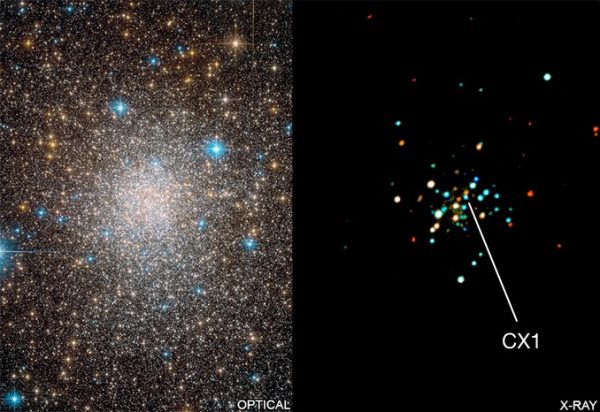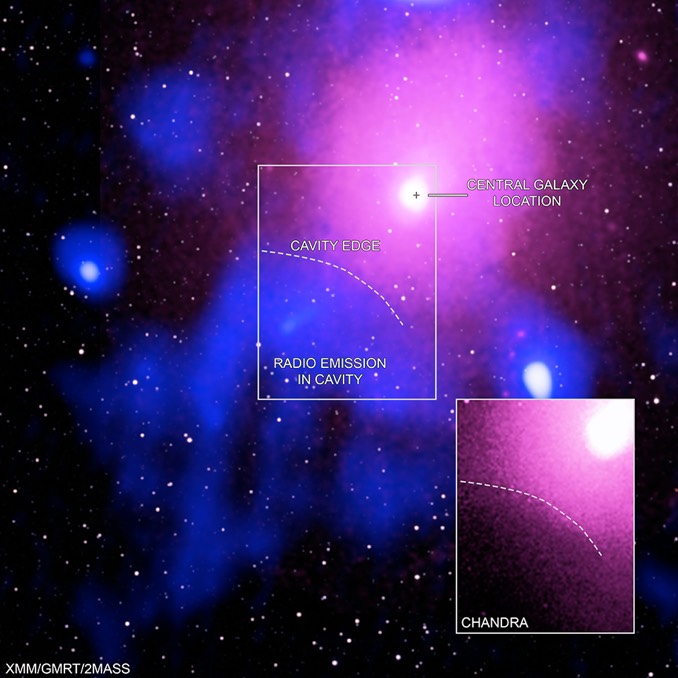Chandra finds Jekyll and Hyde binary; also detects signs of record blast – Astronomy Now Online

The Chandra X-ray Observatory has spotted a binary star system in a globular cluster that is switching between two states in Jekyll and Hyde fashion as a small-but-massive neutron star siphons off material from a co-orbiting Sun-like star. The telescope also has detected signs of the most powerful explosion yet observed
Located about 19,000 light years from Earth in a globular cluster known as Terzan 5, the binary system – Terzan 5 CX1 – has been observed for almost two decades. Observations in 2003 indicated the system is a low-mass X-ray binary in which in-falling material from the Sun-like star spirals into an accretion disc around the more massive neutron star, heats up and emits detectable X-rays.
Over several billion years, as material in the accretion disc falls onto the neutron star, its rotation can increase to several hundred spins per second. When accretion finally slows, the neutron star’s magnetic field can sweep remaining material away, generating rapid radio pulses.
The evolution of a low-mass X-ray binary into a millisecond pulsar doesn’t happen in one step. During a transition period, the system can switch back and forth between the two states.
That appears to be the case with Terzan 5 CX1. In the 2003 observations, its X-ray emissions were brighter than any other sources in the host cluster, indicating the neutron star was pulling in matter from the companion star. Between 2009 and 2014, however, the system was 10 times fainter in X-rays and radio emissions were detected. While millisecond radio pulses were not detected, the spectra were consistent with what could be expected from a millisecond pulsar.
When Chandra observed Terzan 5 CX1 again in 2016, X-ray emissions had increased and it was again behaving like a low-mass X-ray binary. More X-ray observations are planned, along with sensitive searches to look for radio pulses that would confirm the transition state. Only three other confirmed examples of such Jekyll and Hyde behaviour are known.
In other Chandra news, astronomers have detected signs of the most powerful explosion ever detected, the aftermath of a titanic blast triggered by a supermassive black hole at the heart of the Ophiuchus galaxy cluster 390 million light years from Earth.

“In some ways, this blast is similar to how the eruption of Mt. St. Helens in 1980 ripped off the top of the mountain,” said Simona Giacintucci of the U.S. Naval Research Laboratory and lead author of a study in The Astrophysical Journal. “A key difference is that you could fit fifteen Milky Way galaxies in a row into the crater this eruption punched into the cluster’s hot gas.”
Hints of the explosion were seen in Chandra data collected in 2016 that indicated a huge cavity in the hot gas permeating the cluster near the central galaxy. A team led by Norbert Werner briefly considered the possibility the observed cavity, or bubble, was the result of an explosion, but concluded the energy required was too extreme to be believable.
The new study, incorporating X-ray data from XMM-Newton and radio observations by the Murchison Widefield Array in Australia and the Giant Metrewave Radio Telescope in India, shows a truly enormous explosion did, in fact occur.
The radio observations in particular “showed very clearly that the extended radio source fits the X-ray edge like a hand in a glove,” co-author Maxim Markevitch of NASA’s Goddard Space Flight Center wrote in a blog post. “This confirms the hypothesis, previously considered implausible, of a giant cavity in the cluster plasma filled with super-energetic electrons that generate the radio emission.”
He added that Werner “was very happy to have been proven too cautious!”
“The bubble in the Ophiuchus cluster is exactly like the bubbles created by the central black holes in other cluster cooling cores, except this bubble is outside the core and its energy is enormous – at least five times that of the previous record holder, MS 0735.6+7421. If such energy were deposited inside the cool core, it would have blown it to shreds.”






